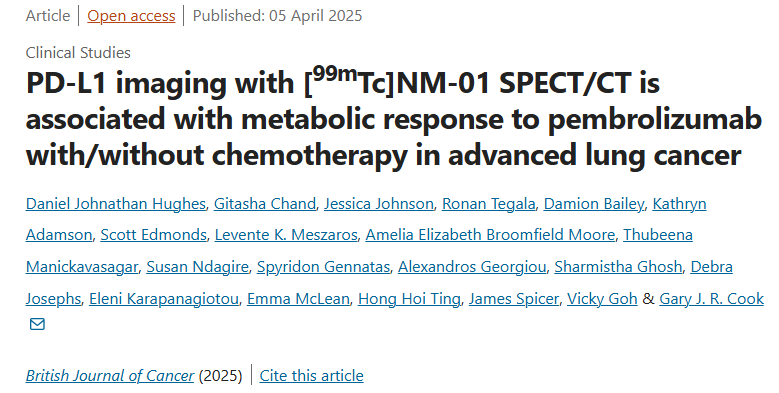Breakthrough in PD-L1 Imaging: Single-Domain Antibody-Based SPECT/CT Predicts Immunotherapy Response in Lung Cancer

In a recent clinical study, researchers demonstrated that imaging with [99mTc]NM-01—a radiolabeled single-domain antibody targeting PD-L1—can predict how patients with advanced non-small cell lung cancer (NSCLC) respond to immunotherapy. This innovative imaging approach offers a promising non-invasive alternative to conventional biopsy-based methods.
The Challenge with Current Biomarkers
PD-L1 expression, typically measured through immunohistochemistry (IHC), is a standard biomarker for determining eligibility for anti-PD-(L)1 therapies like pembrolizumab. However, IHC can be limited by sampling errors, tumor heterogeneity, and invasive procedures—raising the need for more comprehensive, non-invasive diagnostic tools.
Introducing the PECan Study
The PECan study (PD-L1 Expression in Cancer; NCT04436406) set out to explore how [99mTc]NM-01 SPECT/CT imaging correlates with clinical response to pembrolizumab, with or without chemotherapy. [99mTc]NM-01 is a single-domain antibody (also known as a VHH or nanobody) engineered to bind PD-L1 and radiolabeled for imaging.
Fifteen patients with advanced NSCLC underwent both [99mTc]NM-01 SPECT/CT and [18F]FDG PET/CT scans before and after 9 weeks of treatment. PD-L1 expression was also measured by the SP263 IHC assay.
Key Findings
[99mTc]NM-01 uptake (measured as tumor-to-blood pool ratio) showed moderate correlation with PD-L1 expression from IHC (r = 0.45, p < 0.05).
Importantly, baseline [99mTc]NM-01 uptake had a stronger correlation with metabolic response on [18F]FDG PET/CT after treatment (r = −0.73, p < 0.05), compared to IHC (r = −0.46, p = 0.06).
The imaging method also revealed intertumoural heterogeneity in 67% of patients—something that is often missed by biopsy.
Why This Matters
This study underscores the power of single-domain antibodies in diagnostic imaging. Their small size, high specificity, and rapid clearance make them ideal for SPECT/CT applications. With [99mTc]NM-01, clinicians can visualize PD-L1 expression across both primary and metastatic sites—non-invasively and in real time.
What It Means for the Future
The success of [99mTc]NM-01 in predicting early treatment response marks a significant step forward in precision oncology. It also highlights the growing impact of VHH-based technologies beyond therapeutics—into imaging, diagnostics, and clinical decision-making.
At AlpalifeBio, we’re proud to support innovation in single-domain antibody discovery and development. We believe technologies like [99mTc]NM-01 are paving the way for smarter, more personalized cancer care.
Interested in developing your own VHH imaging agents?
Reach out to us and explore how our immunization and VHH library construction services can accelerate your next breakthrough.
Reference: Nature